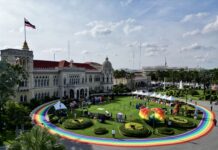With COVID-19 cases on the rise and the Thanksgiving holiday just around the corner, health experts and government officials are urging citizens to maintain social distancing practices, fearing potential outbreaks due to large, widespread gatherings. There are no concrete restrictions upon students and faculty who wish to spend the long weekend at home with their families; UCR is striving to maintain a balance between keeping community residents safe and allowing individuals to enjoy the upcoming break as well as possible. However, students who live in the residence halls are expressing particular concern at the risks that come with allowing people to travel home.

One student, Jenni Quoi, a first-year Asian studies major, assured The Highlander that UCR has been doing relatively well in terms of taking precautionary measures against the virus thus far; however, she also added that the school could work on better enforcement of social distancing in general. With the impending Thanksgiving break, this criticism has become that much more pressing to Quoi, considering the possible repercussions of students heading to different areas for the break while planning to return to school afterward. Though she is also spending the holiday at home with family, Quoi harbors qualms over UCR’s plans to mitigate a potential viral spread when students come back to their dorms. “I think the majority of my fear is them bringing back a potential risk of COVID.” she stated.
Another student, Julie Vasquez, a first-year global studies major, shared a similar sentiment. She praised the university’s COVID-19 protocol, from the weekly testing requirements to daily common area sanitization, but expressed strong apprehension over what might happen due to the upcoming break. Vasquez affirmed that she is choosing not to go home for Thanksgiving or the subsequent winter break, as she does not want to entertain any risk of spreading the virus.
“I’m worried that many people who do decide to go back fome for the holidays won’t be so cautious and possibly come back positive with the virus,” she stated.
Vasquez went on to say that the potential lack of caution will undoubtedly endanger the health of students who are living on campus, and increase the likelihood of all students being sent back home. “There’s always someone who doesn’t follow the rules, so it is likely to happen,” she stated, adding that if the university reaches around a 10% positive test rate, then all students will have to move back home. To Vasquez, the situation is frustrating, and especially unfair to those who are going to be spending their holiday time off adhering to social distancing rules and avoiding gatherings.
However, Bob Brumbaugh, senior director of UCR housing services, assured The Highlander that the school has set up a comprehensive plan for those students going home for Thanksgiving. Since Riverside County regressed to tier one, the university faces “a profoundly inconvenient influence on residents post-Thanksgiving and Winter break.”
According to Brumbaugh, student residents in all housing units, from residence halls to family housing, are required to “sequester” themselves for at least 14 days after returning from Thanksgiving break and winter break, regardless of whether or not they plan on leaving campus. Sequestering means that the students are not to leave their rooms or apartments, unless they are going to secure essentials, such as medical services or food. Those residing in the residence halls will be required to obtain four negative COVID tests during that time in order to be released from the sequester period; while those living in campus apartments and family housing units will be mandated to secure two negative test results during that time frame.
For those who live in the residence halls, the staff is taking an extra precautionary measure by asking returning individuals to sign up for a self-selected appointment time and date in order to move back into their room. Brumbaugh explained that this will decrease the amount of students moving around the buildings at one time, hopefully increasing the ability of students to physically distance themselves from others.
A mass email from Chancellor Kim A. Wilcox confirmed this information, adding that students in need of extra support or help navigating this phase of the pandemic can and should take advantage of the university resources. Still, in spite of the newly instated restrictions and guidelines, Wilcox concluded on a positive note. “Your resilience and commitment to our community throughout the pandemic has been remarkable.” He finished,”Please remain diligent in your personal efforts to stay healthy and safe while also supporting those around you.”







